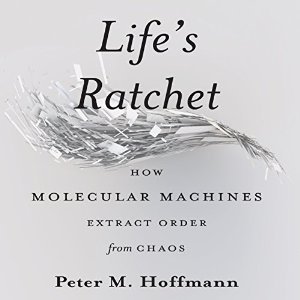Read Life's Ratchet: How Molecular Machines Extract Order from Chaos - Peter M. Hoffmann file in PDF
Related searches:
Life's Ratchet: How Molecular Machines Extract Order from Chaos 1
Life's Ratchet How Molecular Machines Extract Order from - Bol.com
Life's Ratchet: How Molecular Machines Extract Order from - NHBS
(PDF) Life's ratchet: how molecular machines extract order from
Life's Ratchet. How Molecular Machines Extract Order from Chaos
Life’s Ratchet: How Molecular Machines Extract Order from
Life's ratchet: how molecular machines extract order from chaos
Life's Ratchet : How Molecular Machines Extract Order from
Life's Ratchet: How Molecular Machines Extract Order From
LifeΓÇÖs Ratchet: How Molecular Machines Extract Order from
Life’s Ratchet: How Molecular Machines Extract Order from Chaos
Below the calm, ordered exterior of a living organism lies microscopic chaos.
Below the calm, ordered exterior of a living organism lies microscopic chaos. Our cells are filled with molecular machines, which, like tiny ratchets, transf.
30 oct 2012 hoffmann distinguishes between macroscopic machines created to serve a specific purpose and the “autonomous [molecular] machines” found.
1 jan 2013 life's ratchet: how molecular machines extract order from chaos.
Life's ratchet is an exciting guide to the wondrous strange nanoworld of molecules driving the machinery of life. “[a] fascinating glimpse into recent research on molecular machines, research that lies at the intersection of biology, chemistry, and physics.
99 publication date: october 30, 2012 isbn (hardcover): 978-0-465-02253-3 category: nonfiction. A biophysicist examines the relationship between chance and necessity at the boundary between life and inanimate objects.
The ratchet in the title is feynman's ratchet, a gedanken experiment described in feynman's lectures on physics and reminiscent of maxwell's demon. The demon was proposed as a way to create a temperature difference without expenditure of energy, by sorting molecules according to their speeds.
6 apr 2017 when exposed to a pulse of ultraviolet light one rotor blade jumped 180 degrees around the central double bond, then the ratchet moved into.
These “molecular machines” use the energy of chaos surrounding them—in which atoms are buffeted by the random motion of the “molecular storm”— to create order and give rise to life.
Hoffmann locates the answer to this age-old question at the nanoscale.
Yet, science tells us that living beings are merely sophisticated structures of lifeless.
Our cells are filled with molecular machines, which, like tiny ratchets, transform random motion into ordered activity, and create the “purpose” that is the hallmark of life.
The world of sub-atomic particles, atoms and molecules is chaos. Cells are molecular machines that spontaneously organize this chaos into self-sustaining processes by consuming and processing energy.
“life's ratchet engagingly tells the story of how science has begun to realize the potential for matter to spontaneously construct complex processes, such as those.
Life's ratchet: how molecular machines extract order from chaos. The cells in our bodies consist of molecules, made up of the same carbon, oxygen, and hydrogen atoms found in air and rocks.
The “physics” of a chemically driven molecular machine—its equation of motion— is beautifully by purcell in his paper “life at low reynold's.
Life's ratchet is an exciting guide to the wondrous strange nanoworld of molecules driving the machinery of life. [a] fascinating glimpse into recent research on molecular machines, research that lies at the intersection of biology, chemistry, and physics.
10 jul 2018 molecular machines presents a dynamic new approach to the physics of shape —this book describes the complex molecules of life from the author of life's ratchet: how molecular machines extract order from chaos.
Hoffmann delivers a profound message about the nature of the life within.
The ratchet, by contrast, has no intelligence; it consists of a nanoscale cogged wheel that can rotate in one direction when impacted by an energetic molecule but is prevented from going in the opposite direction by a sensitive pawl. It can be shown (as hoffman explains) that neither of these machines can work as conceived.
In life’s ratchet: how molecular machines extract order from chaos, peter hoffmann offers a fascinating glimpse into recent research on molecular-machines, research that lies at the intersection of biology, chemistry, and physics. He explains the unexpected ways that machine-like functions are accomplished by molecules and discusses conceptual similarities between how molecular machines operate and the mechanisms by which biological organisms evolve.
Subjects: life sciences, cell biology and developmental biology, molecular biology, biochemistry, and structural biology.
That last question is the subject of peter hoffmann's fine book, life's ratchet: how molecular machines extract order.
It presents a historical perspective of how the physics (and partly the chemistry) of molecular motors has developed, and combines that with a wealth of recent information about what we know of the microscopic physics of molecular motors. The subtitle of the book could perhaps be “a physicist’s perspective of the workings of life”.
Hoffmann locates the answer to this age-old question at the nanoscale. Below the calm, ordered exterior of a living organism lies microscopic chaos, or what hoffmann calls the molecular storm -- specialized molecules immersed in a whirlwind of colliding water molecules.
Our cells are filled with molecular machines, which, like tiny ratchets, transform random motion into ordered activity, and create the purpose that is the hallmark of life.

Post Your Comments: